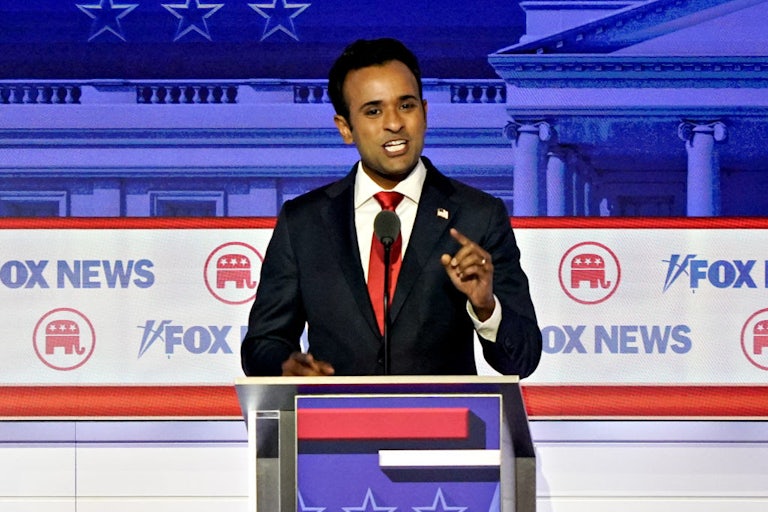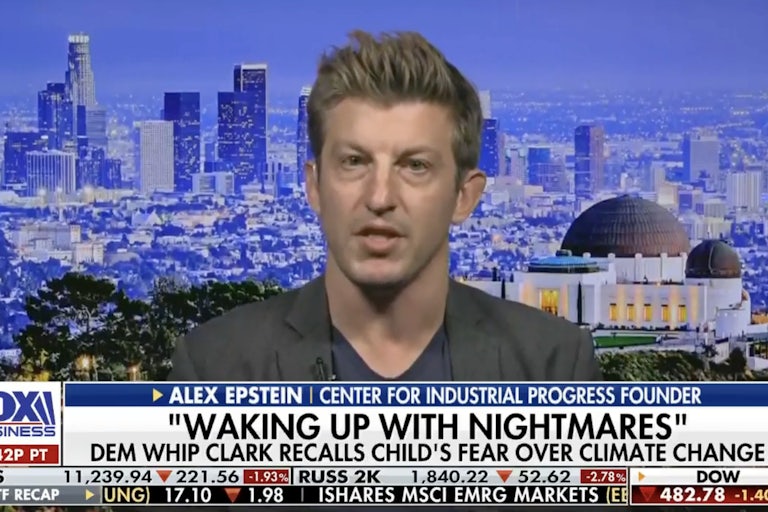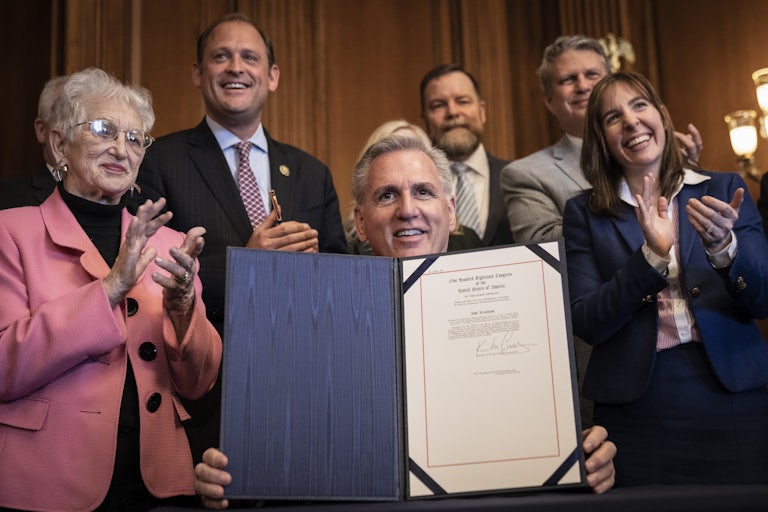Vivek Ramaswamy Is Teaching the GOP to Weaponize Climate
The candidate is demonstrating a new way of Republican campaigning: with climate change front and center.

On the debate stage in Milwaukee last week, the eight Republican candidates in attendance got a surprising question from the moderators: Do you believe in human-caused climate change? Only Vivek Ramaswamy, the 38-year-old former pharmaceutical executive who has seen a surprising spike in polling over the summer, seemed to have a sound bite ready.
“The climate change agenda is a hoax,” he said. “The reality is more people are dying of bad climate change policies than they are of actual climate change.”
Ramaswamy’s answer didn’t come out of left field. Demonizing climate policy has been central to his campaign from the start. Ramaswamy represents a new, and worrying, evolution of Republican campaigning in an age of increasingly hot summers, boiling oceans, and devastating wildfires: Rather than ignoring climate change or dismissing its science as unsettled, he’s weaponizing it as an issue, turning climate policy into a culture-war villain. Given his recent rise in popularity, it’s past time for those concerned about the future of the planet to start scrutinizing what he’s doing.
The GOP’s response to climate change has been historically shaped by one of its favorite donors: the fossil fuel industry. Before the late 2000s, major party figures like George W. Bush and John McCain professed concern about climate change. The GOP’s commitment to climate denial really took off after 2008, when oil interests began to marshal opposition to a proposed cap-and-trade tax on carbon emissions—the first, and one of the only, major efforts to pass climate legislation in the United States. Accordingly, opposition to climate action from GOP politicians in subsequent years has mimicked the pattern set by decades of fossil fuel denial from these same oil companies: Question the validity and certainty of climate science to delay meaningful action, and distract voters with other tactics and issues.
For the next 15 years, it was this oil-inspired anti-science rhetoric—coupled with accusations that Democrats’ favored climate policies would destroy fossil fuel jobs—that dominated Republicans’ rhetoric about climate change. As a result, climate change was rarely the focus of a Republican candidacy or presidency but a sideshow to be dealt with quietly: something that a Democratic opponent or a TV anchor might bring up that could be hand-waved with a claim that the science was not yet settled. Even Donald Trump, who made various (muddled) statements about climate change being a hoax and pandered heavily to coal miners on the campaign trail, never really made it a major talking point. He left the real work to be done by cronies like EPA chief Scott Pruitt, who used his scant media appearances to consistently (and falsely) cast doubt on climate science.
A few things have changed in recent years that have set the stage for a new kind of GOP candidate like Ramaswamy, who deliberately puts climate at the center of his campaign. Thanks in large part to the Inflation Reduction Act and other Biden administration policies, climate policy is now baked into federal legislation in ways it wasn’t before, giving the GOP much more fodder to push back on. Republicans also have been hard at work fanning the flames of various culture wars in recent years—including anti–environmental, social, and governance, or ESG, investment sentiment, which has rapidly become a top Republican bugaboo. The rise of QAnon-fueled conspiracy theories and candidates have made pinning various issues on a conspiracy of “elites”—as Ramaswamy does with climate—much more acceptable in mainstream political discourse. Last, climate change has simply become much harder to ignore and is shaping up to possibly become a wedge issue with future generations: The only audience question posed at the Republican debate came from a student who noted polling that shows climate change is one of young people’s top concerns.
These conditions are ripe for a candidate like Ramaswamy. Before he decided to run for president, Ramaswamy had created a name for himself as an anti-ESG campaigner, authoring a book railing against the “modern woke-industrial complex.” The evils of diversity, equity, and inclusion, in his rhetoric, are inseparable from climate action. “End the climate cult” has been a consistent talking point from the beginning of his campaign. “The Left’s commandments: Race, Gender, Sexuality, Climate,” Ramaswamy posted on X earlier this month. “We can’t just be against their vision. We must offer our own: God. Nation. Family. Individual.” It’s a nonsense statement—he’s just naming universal concepts, not actual commandments like, say, Thou shalt not destroy our only planet. But if Ramaswamy’s polling numbers are any indication, this kind of nonsense seems to be working.
Good News, Bad News
![]()
“Tiny forests”—trees and foliage planted on little lots—are increasing in popularity in the U.S., and can sequester a surprising amount of carbon while being extremely easy to maintain.
![]()
Scientists estimate that more than 9,000 emperor penguin chicks died last year in Antarctica thanks to unprecedentedly low levels of sea ice—a worrying number for an endangered species facing consistent habitat loss.
Stat of the Week
91.2°F
That’s the temperature taken in the ocean off the Florida Keys on Monday—an unusually warm reading. Warm oceans helped strengthen Hurricane Idalia, which made landfall as a Category 3 storm on Wednesday.
Elsewhere in the Ecosystem
A book could literally kill you. That’s what mycologists are warning the public about as booksellers like Amazon offer mushroom-foraging books likely written by artificial intelligence, not humans, 404 Media reports:
Amazon has an AI-generated books problem that’s been documented by journalists for months. Many of these books are obviously gibberish designed to make money. But experts say that AI-generated foraging books, specifically, could actually kill people if they eat the wrong mushroom because a guidebook written by an AI prompt said it was safe.…
“There are hundreds of poisonous fungi in North America and several that are deadly,” Sigrid Jakob, president of the New York Mycological Society, told me in an email. “They can look similar to popular edible species. A poor description in a book can mislead someone to eat a poisonous mushroom.”
Read Samantha Cole’s full piece at 404 Media.
This article first appeared in Life in a Warming World, a weekly TNR newsletter authored by contributing deputy editor Molly Taft. Sign up here.




.png)






